|
|
Effect of Particle Grading on Properties of Silicon Carbide Ceramics by Binder Jetting Printing
GU Xuesu, YIN Jie, WANG Kanglong, CUI Chong, MEI Hui, CHEN Zhongming, LIU Xuejian, HUANG Zhengren
2023 Vol. 38 (12): 1373–1378
 Abstract
Abstract(
633 )
 HTML
HTML(
42)
 PDF
PDF(880KB)(
630
)
Silicon carbide (SiC) ceramics, as a high-performance structural-functional integrated material, are widely used in aerospace, nuclear industry and braking system. However, the conventional fabrication methods can not meet the increasing demands for large-scale and complex-structured SiC ceramics, such as engine nozzles, flaps and turbine blades. Binder jetting (BJ) 3D printing technology can overcome the traditional obstacle and provide a novel manufacturing roadmap. Here, we adopted this technique via SiC particle grading, optimized the particle size ratio based on gradation theory, and studied the influence of BJ printing on properties of SiC green body and as-sintered ceramic. For the particle-graded green body after BJ printing, SiC ceramics with a maximum flexural strength of (16.70±0.53) MPa was obtained after one precursor impregnation and pyrolysis (PIP) treatment, whose flexural strength was improved by 116% as compared with that BJ printed from a median diameter of 20 μm. SiC ceramics were further densified using liquid phase siliconization, with the density, flexural strength, elastic modulus, and fracture toughness reaching (2.655±0.001) g/cm3, (285±30) MPa, (243±12) GPa, and (2.54±0.02) MPa·m1/2, respectively. XRD results demonstrated that the sintered SiC ceramics were mainly composed of 3C structured-β-SiC. All results show that high-performance SiC ceramic materials are innovatively prepared by an efficient and reliable method, based on the combined techniques of particle grading, BJ printing, PIP and liquid silicon infiltration.
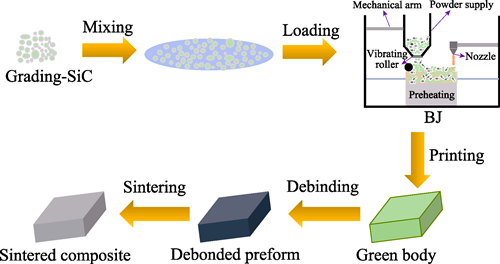
|
|
|
Effect of Cu/Mg Ratio on CO2 Adsorption Performance of Cu/Mg-MOF-74
LING Jie, ZHOU Anning, WANG Wenzhen, JIA Xinyu, MA Mengdan
2023 Vol. 38 (12): 1379–1386
 Abstract
Abstract(
313 )
 HTML
HTML(
29)
 PDF
PDF(1219KB)(
592
)
Cu/Mg-MOF-74 has several advantages, such as high specific surface area, adjustable microporous structure, alkali metal active site, excellent CO2 adsorption, and good photocatalytic activity. However, how the molar ratio of Cu/Mg (Cu/Mg ratio) affects its CO2 adsorption selectivity in a simulated flue gas is still unclear. Here, a synthesized Cu/Mg-MOF-74, with series of Cu/Mg ratios, using the solvothermal method was analyzed about its CO2 photocatalytic performance, CO2 and N2 uptake, and pore structure. The CO2 adsorption selectivity was calculated to reveal the effect of Cu/Mg ratio on CO2 and N2 uptake and selectivity. The results indicate that the photocatalytic activity of Cu/Mg-MOF-74 for CO2 reduction to CO and H2 initially increases and then decreases with Cu/Mg ratio decreasing. At the Cu/Mg ratio of 0.6/0.4, the yield of CO and H2 by photocatalytic reduction is the highest, showing up to 10.65 and 5.41 μmol·h−1·gcat−1 (1 MPa, 150 ℃), respectively. Furthermore, CO2 and N2 uptakes of Cu/Mg-MOF-74 increase as the Cu/Mg ratio decreases, and the increase in CO2 uptake is more pronounced. At the Cu/Mg ratio of 0.1/0.9, the CO2 and N2 uptakes are the largest, reaching 9.21 and 1.49 mmol·g−1 (273.15 K, 100 kPa), respectively. Their area and volume of micropore (d1 ≥ 0.7 nm) and ultramicropore (d2 < 0.7 nm) increase as the Cu/Mg ratio decreases. At the Cu/Mg ratio of 0.22/0.78, the area and volume of micropores and ultramicropores are larger than those of Mg-MOF-74. The selectivity of Cu/Mg-MOF-74 increases correspondingly with Cu/Mg ratio decreasing and CO2 concentration increasing. CO2 adsorption on Cu/Mg-MOF-74 is a combination process of pore-filling and Mg2+ chemical adsorption in which the micropore volume is the key factor affecting its adsorption performance. All above data demonstrate that modulating the Cu/Mg ratio can promisingly regulate the pore structure of Cu/Mg-MOF-74, CO2 uptake, and selectivity.

|
|
|
Performance Optimization of Ultra-long Stable Mixed Cation Perovskite Solar Cells
MA Tingting, WANG Zhipeng, ZHANG Mei, GUO Min
2023 Vol. 38 (12): 1387–1395
 Abstract
Abstract(
272 )
 HTML
HTML(
16)
 PDF
PDF(2475KB)(
393
)
Perovskite solar cells (PSCs) are developing rapidly and their power conversion efficiency (PCE) has been repeatedly refreshed, but their long-term stability still needs to be improved. At present, most of the preparation of high-efficiency PSCs is completed in the inert gas, with high cost and limited operating space, which is not conducive to its industrial application. Here, perovskite solar cells with mixed cation, displaying ultra-long stability, were successfully prepared in the air. Effects of A-site cation doping on the microstructure, optoelectronic properties and stability of the perovskite were systematically investigated. The experimental results show that FA+ and Cs+ co-doping improves the quality of perovskite films, modulates the energy level arrangement of perovskite/SnO2, suppresses carrier complexation, and significantly improves the PCE, long-term, wet and thermal stability of the cell. The optimal PCE of Cs0.05MA0.35FA0.6PbI3 cells is 19.34%, maintaining 85% of the initial efficiency after reserving for 242 d in dark environment at (20±5) ℃ and <5% relative humidity. In contrast, the PCE of the MAPbI3 cell decreased to 30% of the initial value after reserving for 112 d under the same test conditions. FA+ and Cs+ co-doping also significantly improved the thermal and moisture resistance of the cells. Cs0.05MA0.35FA0.6PbI3 PSCs remain 99% and 84% of initial PCE after aging for 96 h at (85±5) ℃ and 20%-30% relative humidity, (20±5) ℃ and 80%-90% relative humidity in the dark, respectively. In contrast, PCEs of MAPbI3 PSCs under the same conditions remain only 70% and 56%. This study provides a reference for the preparation of highly efficient and ultra-long stable mixed cation solar cells in the air.
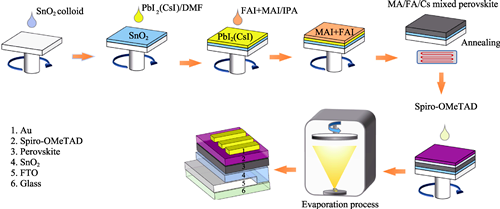
|
|
|
Effects of Different Element Doping on Microstructure and Thermoelectric Properties of CaTiO3
LI Jianbo, TIAN Zhen, JIANG Quanwei, YU Lifeng, KANG Huijun, CAO Zhiqiang, WANG Tongmin
2023 Vol. 38 (12): 1396–1404
 Abstract
Abstract(
271 )
 HTML
HTML(
27)
 PDF
PDF(9077KB)(
643
)
Despite the growing research in CaTiO3 as a novel high-temperature oxide thermoelectric material, effects of various elements doping on the microstructure and thermoelectric performance of CaTiO3 have not been fully understood. Here, a combination of hydrothermal synthesis and vacuum hot-press sintering techniques was employed to fabricate polycrystalline bulks of CaTiO3 doped with six elements: Cr, Nb, Eu, Dy, Ce, and La. Cr doping resulted in substantial precipitation of nanoscale Cr phases, leading to a severely compromised power factor and a ZT of only 0.012 at 983 K due to insufficient donor element concentration in the matrix. Incorporating Eu as a donor carrier in the matrix is proved ineffective, resulting in a marginal ZT enhancement of 0.141 at 1031 K. Nb doping resulted in the formation of micrometer-scale Nb phases with high thermal conductivity, leading to an elevation in thermal conductivity. However, the relatively higher Nb concentration in the matrix provided carriers, resulting in a noticeable ZT improvement to 0.263 at 1013 K. On the contrary, Dy, Ce, and La doping exhibited remarkable dual functionality as donor dopants and point defects, thereby significantly enhancing the power factor and concurrently reducing the lattice thermal conductivity. These improvements were achieved through efficient manipulation of carrier concentration and implementation of phonon scattering. As a result, the thermoelectric figure of merit (ZT) reached 0.357, 0.398, and 0.329 at 1031 K for Dy, Ce, and La-doped CaTiO3 bulks, respectively. These values represent an extraordinary improvement of 296%, 342%, and 265%, respectively, as compared to that of the pristine CaTiO3 (0.096 @1031 K). Notably, Dy-doped samples exhibited significantly reduced lattice thermal conductivity and comparatively higher power factors over the entire temperature range. Regulating Dy content and enhancing the second phase at grain boundaries enabled the decoupling of electrical and thermal transport properties, potentially surpassing the current ZT record of CaTiO3. This study provides valuable insights into the relationships among composition, structure, and performance in CaTiO3 doped with various elements, offering theoretical support for high-temperature thermoelectric applications.
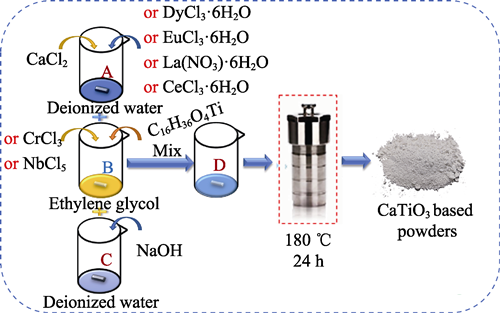
|
|
|
Optimization Design of MPCVD Single Crystal Diamond Growth Based on Plasma Diagnostics
LI Yicun, HAO Xiaobin, DAI Bing, WEN Dongyue, ZHU Jiaqi, GENG Fangjuan, YUE Weiping, LIN Weiqun
2023 Vol. 38 (12): 1405–1412
 Abstract
Abstract(
366 )
 HTML
HTML(
25)
 PDF
PDF(2248KB)(
887
)
Microwave plasma chemical vapor deposition (MPCVD) technology is an ideal way to prepare large size and high-quality single crystal diamonds. However, the complexity of MPCVD single crystal diamond growth and the diversity of crystal growth requirements make it difficult to optimize the growth process. To address this issue, a systematic design method for MPCVD single crystal diamond growth based on plasma diagnostic technology was proposed, using plasma imaging and spectral analysis to quantitatively diagnose microwave plasma. The physical coupling characteristics and quantitative relationship between pressure, microwave(MW) power, plasma properties, and substrate temperature were studied by using home-made MPCVD system. And the size of major axis, precursor group concentration and distribution, energy density, and other data of the plasma under different parameters were obtained. Based on experimental data, the growth process map of single crystal diamond was obtained. According to this map, we selected process parameters by growth temperature and growth area. Through experimental verification, it is shown that this map is usful for guiding prediction with parameter error of less than 5%. Simultaneously, based on the predicted map, growth of single crystal diamond under different plasma energy densitiesis studied. At lower power (2600 W), a higher energy density (148.5 W/cm3) was obtained, and the concentration of carbon containing precursors was higher than that of the other parameters, resulting in a higher growth rate (8.9 μm/h). By this method system, effective plasma control and process optimization can be carried out meeting for different single crystal diamond growth.

|
|
|
Uniform Growth of Two-inch MPCVD Optical Grade Diamond Film
CHAN Siyi, TU Juping, HUANG Ke, SHAO Siwu, YANG Zhiliang, LIU Peng, LIU Jinlong, CHEN Liangxian, WEI Junjun, AN Kang, ZHENG Yuting, LI Chengming
2023 Vol. 38 (12): 1413–1419
 Abstract
Abstract(
282 )
 HTML
HTML(
17)
 PDF
PDF(901KB)(
502
)
The uniform growth of large-size optical grade diamond films has been one of the hot spots and difficulties in the field of microwave plasma chemical vapor deposition (MPCVD) diamond research, in which the structure and position of the deposition platform are crucial to the uniformity of diamond films and the long-term stability of thick film growth. Here, the effect of deposition platform height on the electric field uniformity, plasma state and temperature uniformity on the substrate surface was investigated by COMSOL simulation combined with experiments to optimize the process parameters for the uniform growth of optical grade diamond films. The 2-inch diamond film with thickness of 337 μm and inhomogeneity <11% was obtained at the optimal deposition platform height of 2 mm. The full width of the Raman half-peak from the center to the edge of the film is in the range of 3-4 cm-1, and the maximum transmittance is 69%-70% in the visible light band and 70% in the infrared light at 10.6 μm. This indicates that thickness and quality of the diamond film are relatively uniform, thus the uniform deposition of 2-inch optical grade diamond film is achieved. Above results show that the deposition platform height has a great influence on the electric field distribution and plasma state on the substrate surface, and the electric field uniformity on the substrate surface is significantly improved with the increase of the deposition height, but the influence on the temperature uniformity is smaller.

|
|
|
Enhanced Resistivity Induced by the Second Phase with Layered Structure in BiFeO3-BaTiO3 Ceramics
KANG Wenshuo, GUO Xiaojie, ZOU Kai, ZHAO Xiangyong, ZHOU Zhiyong, LIANG Ruihong
2023 Vol. 38 (12): 1420–1426
 Abstract
Abstract(
235 )
 HTML
HTML(
13)
 PDF
PDF(2938KB)(
531
)
BiFeO3-BaTiO3 (BF-BT) ceramics possess both high Curie temperature and excellent piezoelectric properties, and have a quite wide application prospects in high-temperature piezoelectric sensors and actuators. However, the resistivity of BF-BT ceramics is too low at high-temperature, which can lead to deterioration or even failure of the device's high-temperature performance. Therefore, improving the resistance performance of BF-BT ceramics is the key issue that must be addressed before its application. However, as a type of ferrite, it is difficult to improve resistivity through conventional methods, such as doping modification and optimizing sintering system. In this work, an abnormal increase in resistivity was discovered in BF-BT ceramics, which was confirmed to be related to the second phase Bi25FeO40. Microstructural analysis shows that the second phase has a special layered periodic structure, in which every three rows of atoms constitute a period, and most defects concentrate in one layer of atoms. The pure Bi25FeO40 was successfully synthesized using traditional solid phase method and introduced as an additive into the 0.70BF-0.30BT component, which can increase the resistivity at 300 ℃ from 1.03 MΩ·cm to 4.33 MΩ·cm. In addition, the results of COMSOL simulation confirm that introducing this second phase can increase the resistivity of the 0.67BF-0.33BT component by one order of magnitude. According to the energy filtering effect, this special structure with high energy barriers can prevent carrier migration and improve the resistivity of BF-BT ceramics. This work provides a practical and feasible method for improving the resistivity of BF-BT ceramics.
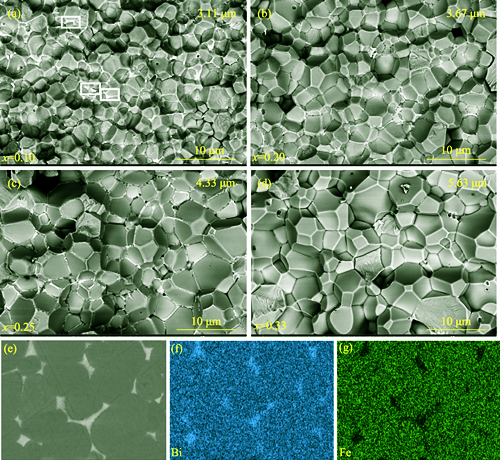
|
|
|
Directly Hydrothermal Growth and Electrochromic Properties of Porous NiMoO4 Nanosheet Films
NIU Haibin, HUANG Jiahui, LI Qianwen, MA Dongyun, WANG Jinmin
2023 Vol. 38 (12): 1427–1433
 Abstract
Abstract(
366 )
 HTML
HTML(
21)
 PDF
PDF(789KB)(
708
)
Nickel molybdate (NiMoO4) is a material with excellent performance in the field of energy storage and catalysis, but lacking of further explorations in the field of electrochromism. In this work, porous NiMoO4 films were grown on transparent conductive glasses by hydrothermal method without using seed layer. Crystalline phase and micromorphology of NiMoO4 nanosheet films were characterized by grazing incidence X-ray diffractometer (GIXRD) and field-emission scanning electron microscope (FESEM), and the electrochromic and electrochemical properties were also investigated by using a UV-Vis-NIR spectrophotometer and an electrochemical workstation. The results show that the NiMoO4 electrochromic films have a porous structure, which can provide sufficient channels for ion migration and reactive sites for the dynamic process of ion intercalation/deintercalation into NiMoO4 film. Therefore, the NiMoO4 films exhibit excellent electrochromic performance, including large optical modulation of 79.6% at 480 nm and high coloring efficiency of 86.2 cm2·C-1. Meanwhile, the coloration and bleaching response time of the NiMoO4 films are 9.5 and 12.7 s, respectively. Interestingly, there is a two-step process in the bleached process of NiMoO4 electrochromic films, including a fast process and a slow process. And the optical modulation can still be maintained at 99.7% of the maximum optical modulation after 100 cycles. In addition, the NiMoO4 films exhibit a large area specific capacitance of 49.59 mF·cm-2 at 0.3 mA·cm-2. These excellent properties support NiMoO4 nanosheet films with promising application in high-performance electrochromic devices. And the next step is to focus on finding the suitable electrolyte and matched counter electrodes in the device assembly.
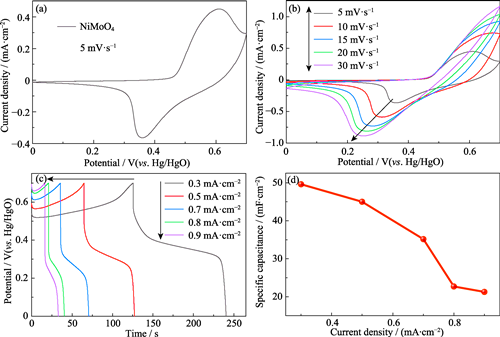
|
|
|
Preparation and Electrochromic Properties of Ti2Nb10O29 Films
SUN Jiawei, WAN Xinyi, YANG Ting, MA Dongyun, WANG Jinmin
2023 Vol. 38 (12): 1434–1440
 Abstract
Abstract(
244 )
 HTML
HTML(
17)
 PDF
PDF(2156KB)(
539
)
Electrochromic materials are energy-saving and environmentally friendly materials that can reduce energy use by adjusting sunlight and solar-heat. In particular, transition metal oxides with stable chemical properties have been widely studied as electrochromic materials. Recently, bimetallic oxides with two variable valence states of metal ions have received increasing attention due to their better electrochemical activity. In this study, Ti2Nb10O29 films were successfully prepared on conductive glasses, and the effect of the atomic ratio of niobium to titanium in the precursor on the electrochromic properties of the thin films was investigated. The results show that the thin film prepared from precursors with an atomic ratio of niobium to titanium of 3 : 1 possesses the best electrochromic properties. It is worth noting that the thin film achieves a large optical modulation in the wavelength range of 300-1100 nm, and the transmittance in the bleached state is nearly 90%, appearing grayish blue under the action of −1.6 V, colorless state under the action of 0.4 V, and achieving a maximum optical modulation of 69.4% at the wavelength of 750 nm. After a square-wave potential of -1.6 V for 60 s and 0.4 V for 15 s, the film shows response time of 29.8 s for coloring and 5.9 s for bleaching. Coloration efficiency of the as-prepared film is 68.3 cm2·C-1. The above results indicate that the successfully prepared Ti2Nb10O29 thin film enriches variety of bimetallic oxide electrochromic materials and has widely application prospect.

|
|
|
Electrophoretic Coating of Magnesium Oxide on Microarc-oxidized Titanium and Its Biological Properties
DU Jiaheng, FAN Xinli, XIAO Dongqin, YIN Yiran, LI Zhong, HE Kui, DUAN Ke
2023 Vol. 38 (12): 1441–1448
 Abstract
Abstract(
261 )
 HTML
HTML(
10)
 PDF
PDF(19901KB)(
515
)
Titanium orthopaedic implants present a risk of infection and require the development of antibacterial, but still biocompatible and non-resistant coatings. Magnesium oxide (MgO) coatings were prepared on micro-arc oxidized titanium by electrophoretic deposition for 15, 30, 45, or 60 s. Nano-sized MgO particles agglomerated to form homogeneous coatings with surface coverage increasing with the duration of deposition. The four groups produced antibacterial rates of 1%, 69%, 83%, and 84% after co-cultured with S. aureus for 6 h, and 81%, 86%, 89%, and 98% after co-cultured for 24 h. Electron and fluorescence microscopies showed decreasing density of bacterial cells and proportion of living cells with increasing time of deposition. Mouse osteoblasts seeded on the four groups had survival rates of 108%, 89%, 53%, and 27% on day 1, and 139%, 117%, 112%, and 66% on day 5. Proportion of dead cells on the coated samples increased with increasing time of deposition but less than 5% on day 5. These results indicate that MgO coatings prepared by electrophoretic deposition for 30 s is reasonable in vitro antibacterial activities and cytocompatibility.
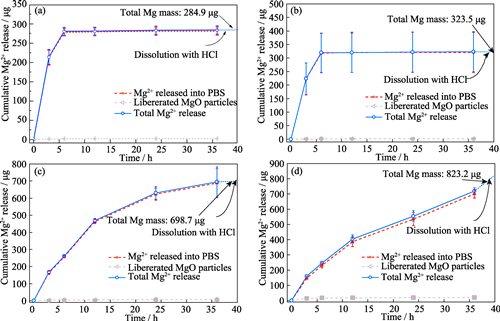
|
|
|
Contrastive Study on in Vitro Antibacterial Property and Biocompatibility of Three Clinical Pulp Capping Agents
XIE Jiaye, LI Liwen, ZHU Qiang
2023 Vol. 38 (12): 1449–1456
 Abstract
Abstract(
227 )
 HTML
HTML(
10)
 PDF
PDF(8917KB)(
563
)
Pulp capping agents are effective materials which can preserve dental pulp and treat caries in different ways. It is urgently demanded to establish a guidance to select the appropriate pulp capping agents according to the conditions of pulp and cary requirements. In this work, morphology, composition, physical, and chemical properties of three commonly used clinical pulp capping agents, namely dental zinc oxide eugenol cement (ZnO), self-curing calcium hydroxide (Dycal), and light-curing calcium hydroxide (Calcimol), were studied. Their antibacterial, cytocompatibility and blood compatibility were evaluated. The results showed that ZnO was hydrophobic and its effective component, crystallized ZnO, could consistently release zinc ions, giving its alkaline environment to inhibit bacteria. Structure, morphology and components in Dycal were similar to those in Calcimol. However, its surface was more hydrophobic and its release amount of calcium ions was larger than that of Calcimol. It formed an alkaline micro-environment, thereby possessed good antibacterial ability and biocompatibility. Meanwhile, Calcimol was hydrophilic and convenient to operate, and released less metal ions. Due to its safe composition, Calciomol exhibited excellent biocompatibility but slightly weaker antibacterial property. Our results suggested that these comparative results might be a useful clinical guidance for selecting appropriate pulp capping agents according to the degree of caries and the health status of dental pulp to treat the caries.
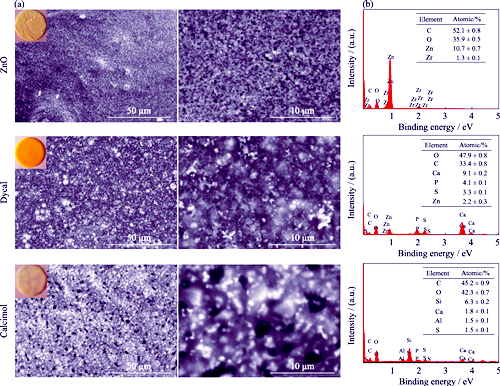
|
|
|
Effects of Surface Wettability of Titanium Oxide Coatings on Osteoimmunomodulatory Properties
SHANGGUAN Li, NIE Xiaoshuang, YE Kuicai, CUI Yuanyuan, QIAO Yuqin
2023 Vol. 38 (12): 1457–1565
 Abstract
Abstract(
211 )
 HTML
HTML(
12)
 PDF
PDF(18527KB)(
333
)
Titanium and its alloys have been widely used as hard tissue implants due to their excellent mechanical properties and biocompatibilities. However, the lack of biological activity on its surface and the inflammatory reaction after implantation can easily lead to unsatisfactory osseointegration. In this work, the wettability of titanium oxide coatings was modulated by annealing in different atmospheres, and the effects of surface wettability on polarization of macrophages and osteogenic differentiation of mBMSCs were studied. The results showed that, compared to the hydrophilic titanium oxide coating (~10º, PEO-A), the titanium oxide coating with contact angle about 90º (PEO-A-V) inhibited the polarization of macrophages towards M1 pro-inflammatory direction under the mono-culture condition. However, under the co-culture condition, the titanium oxide coating with contact angle about 90º promoted macrophage polarization towards M2 and significantly upregulated gene expressions of osteogenic markers related to mBMSCs, indicating better immunomodulatory effects on osteogenic differentiation of mBMSCs.
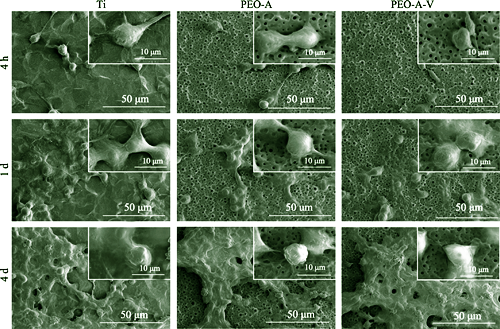
|
|
|
Jointing of Cathode Coating and Interface Modification for Stabilizing Poly(ethylene oxide) Electrolytes Against High-voltage Cathodes
TAN Shuyu, LIU Xiaoning, BI Zhijie, WAN Yong, GUO Xiangxin
2023 Vol. 38 (12): 1466–1474
 Abstract
Abstract(
321 )
 HTML
HTML(
17)
 PDF
PDF(10947KB)(
466
)
Poly(ethylene oxide) (PEO)-based solid electrolytes are deemed as the most promising alternatives for solid-state lithium batteries on account of their low cost, good stability against Li metal, and easy large-scale production. However, the instability of PEO against high-voltage cathodes severely limits its application in the fields needing high energy density. In this work, a discontinuous cyclized polyacrylonitrile (cPAN) nanolayer, served as an electron-conducting shell, is partially coated on LiNi0.6Co0.2Mn0.2O2 (NCM) cathode particles, while an ionic liquid acted as ion-conducting pathway is introduced at NCM/PEO interface, enabling the high compatibility of PEO against high-voltage NCM cathode. The cPAN layer not only physically isolates the direct contact of PEO electrolyte from NCM cathode, but also contributes to the electronic transfer inside the cathode due to the formation of delocalized sp2 π bond during coating process. Meanwhile, the mobile ionic liquid with good ionic conductivity fully wets cathodic interface, followed by decomposition into cathode-electrolyte interphase (CEI) of LiF and Li3N, further restricting the oxidation-failure of PEO electrolyte. By taking the combined strategy, the corresponding solid-state NCM/Li battery delivers an excellent electrochemical performance with a capacity retention of 85.3% after 100 cycles at rate of 0.1C (1C=0.18 A·g-1) under a cutoff voltage of 4.30 V. This work opens up a new direction to address the interfacial stability issues of PEO-based electrolyte against high-voltage cathodes through surface coating and interface modification.
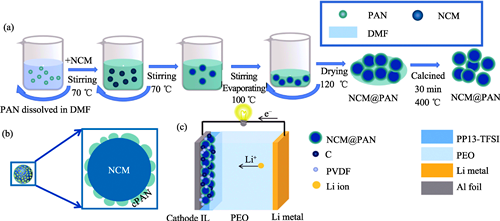
|
|
|
Crystal Growth and Structural, Optical, and Visible Fluorescence Traits of Dy3+-doped SrGdGa3O7 Crystal
WANG Haidong, WANG Yan, ZHU Zhaojie, LI Jianfu, LAKSHMINARAYANA Gandham, TU Chaoyang
2023 Vol. 38 (12): 1475–1482
 Abstract
Abstract(
159 )
 HTML
HTML(
14)
 PDF
PDF(2304KB)(
388
)
Dy3+-doped SrGdGa3O7 crystal was successfully grown through the Czochralski method and investigated in detail for its structural and optical features. Its crystallographic lattice parameters were optimized by Rietveld refinement based on XRD data. Polarized absorption spectra, polarized emission spectra, and fluorescence decay curves of Dy: SrGdGa3O7 crystal were analyzed. Absorption cross-sections at 452 nm corresponding to π- and σ-polarization were computed as 0.594×10-21 and 0.555×10-21 cm2, respectively. Calculated effective J-O intensity parameters Ω2, Ω4, and Ω6 were 5.495×10-20, 1.476×10-20, and 1.110×10-20 cm2, respectively. J-O analysis and emission spectra show that transition 4F9/2→6H13/2 of Dy: SrGdGa3O7 crystal has the highest fluorescence branching ratio and fluorescence intensity under 452 nm excitation within the visible spectral region, the emission cross-sections of π- and σ-polarization were 1.84×10-21 and 2.49×10-21 cm2 at the wavelength of 574 nm, respectively. The measured radiative lifetime and fluorescence decay time of the Dy3+: 4F9/2 level were 0.768 and 0.531 ms with a quantum efficiency of 69.1%. All these results reveal that Dy3+: SrGdGa3O7 crystal is a promising material for yellow lasers pumped with blue laser diodes.
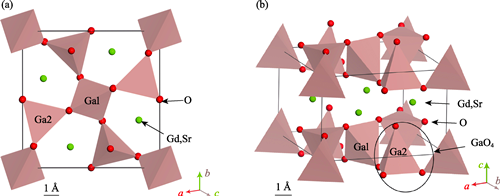
|
|
|
Metre-scale Y3Al5O12 (YAG) Transparent Ceramics by Vacuum Reactive Sintering
WANG Dewen, WANG Junping, YUAN Houcheng, LIU Zhang, ZHOU Jin, DENG Jiajie, WANG Xin, WU Benhua, ZHANG Jian, WANG Shiwei
2023 Vol. 38 (12): 1483–1484
 Abstract
Abstract(
386 )
 HTML
HTML(
21)
 PDF
PDF(1760KB)(
572
)
Transparent ceramic materials have excellent strength, hardness and optical properties, which have important application prospect in light-weight transparent protective armor. However, the preparation of transparent ceramic components with large protection area and high transmittance properties is the main challenge to achieve application. In this work, large-size yttrium aluminum garnet (Y3Al5O12, abbreviated as YAG) transparent ceramics with low deformation and excellent optical quality were fabricated by reactive sintering in vacuum using domestic high-purity Al2O3 and Y2O3 powders as starting materials, and the key technologies including dry pressing, calcining, high-temperature vacuum sintering and optical performance were broken through. In addition, as the upgrading of molding and sintering equipment, the dimension of YAG transparent ceramic was enlarged to 1040 mm×810 mm×15 mm, laying a substantial foundation for future applications.
|
|